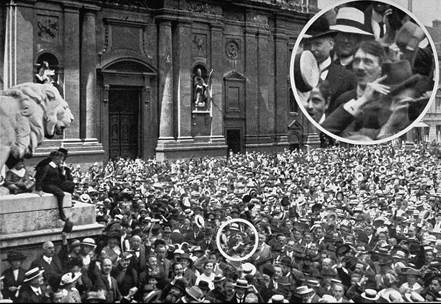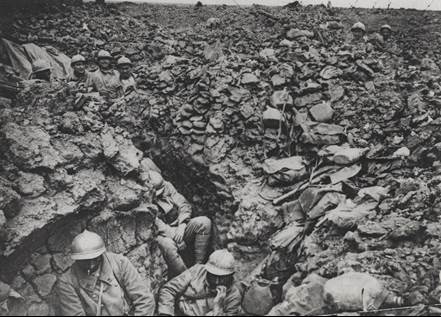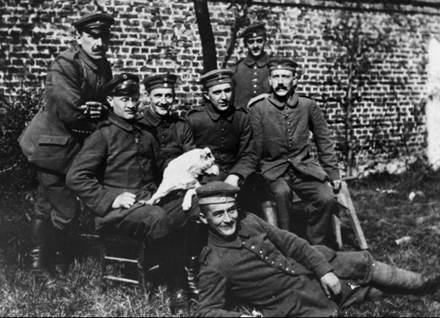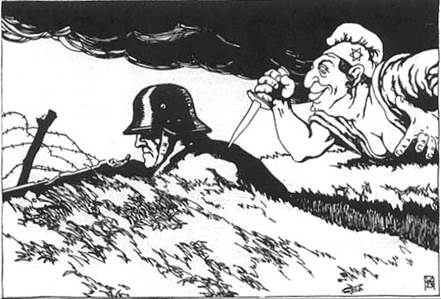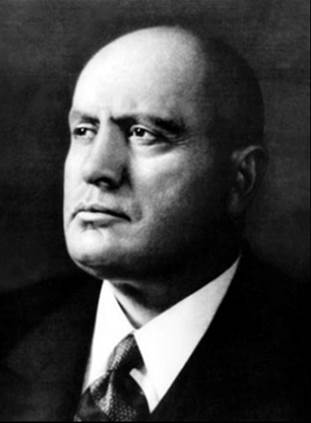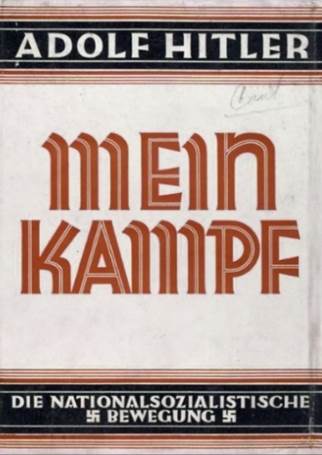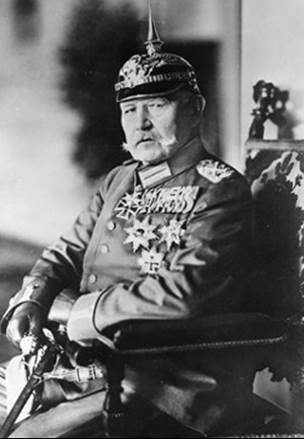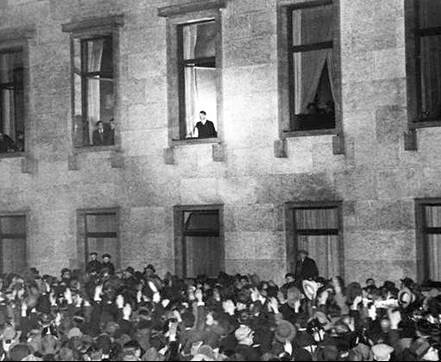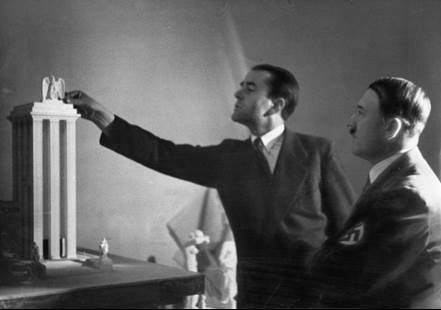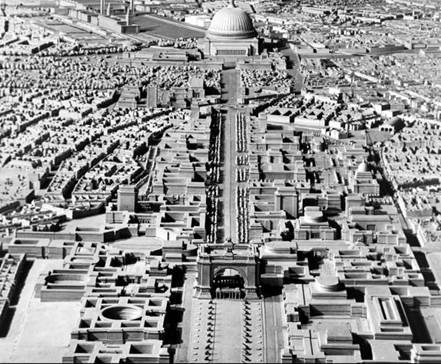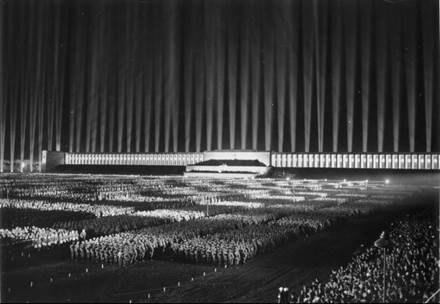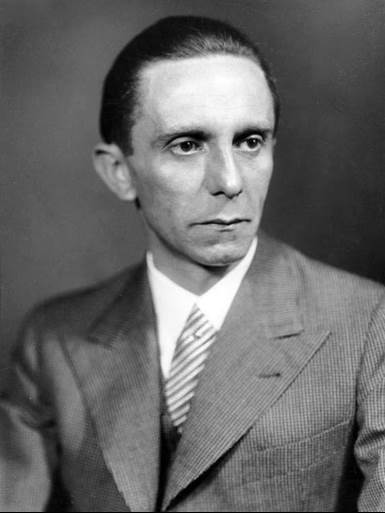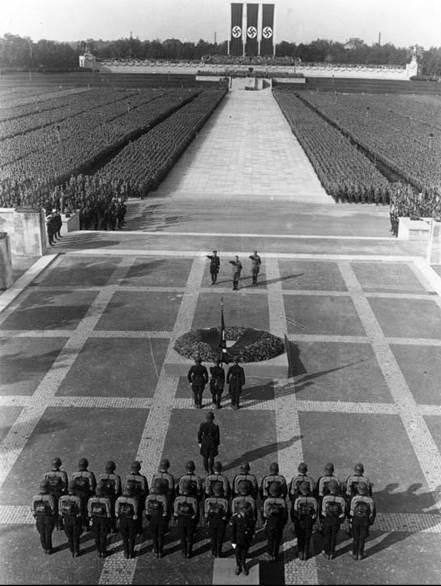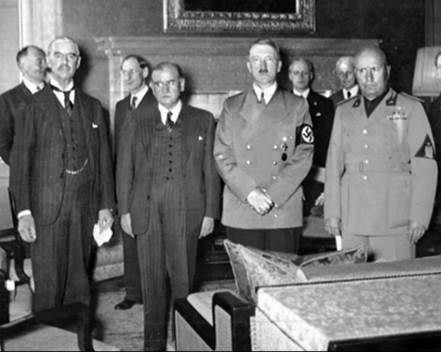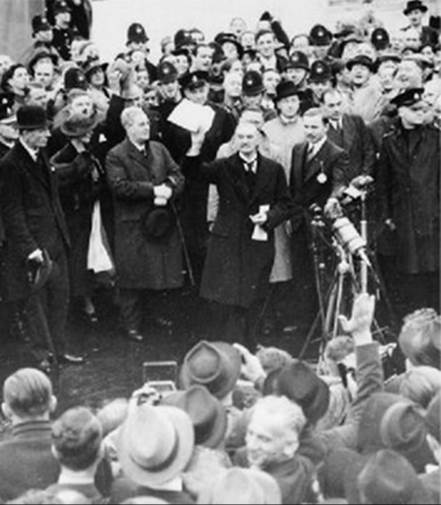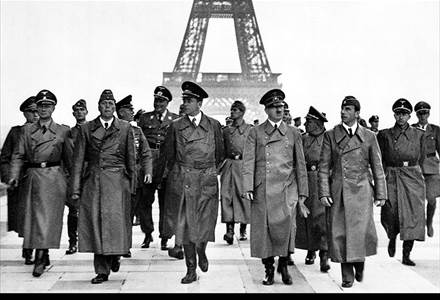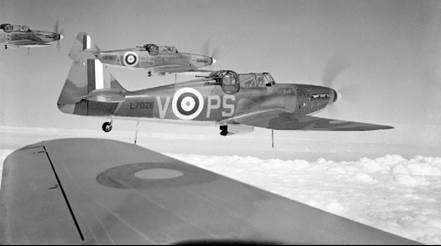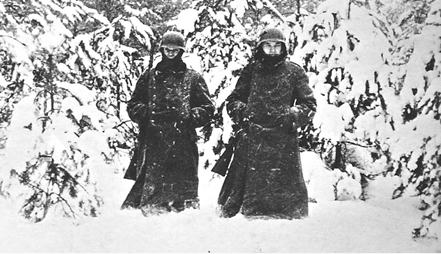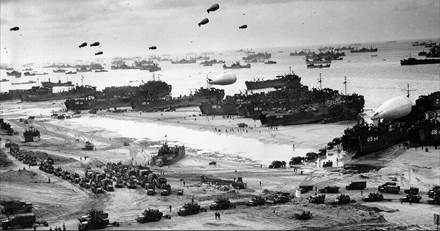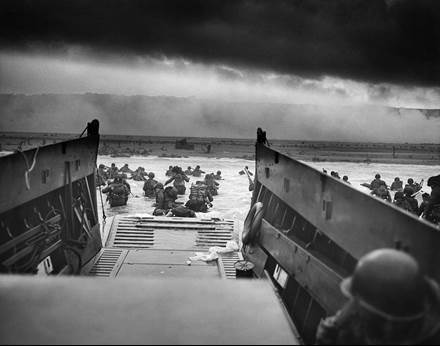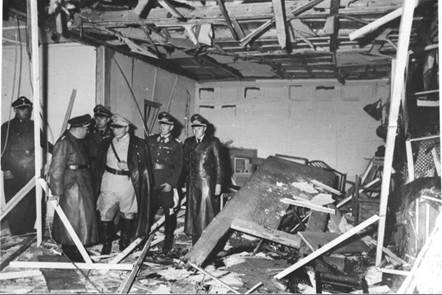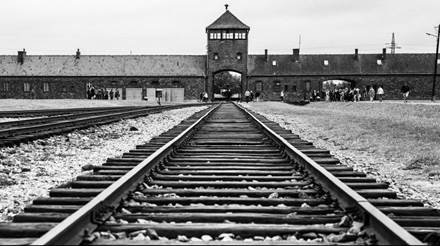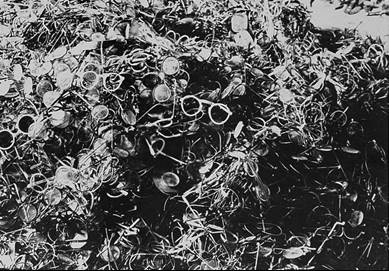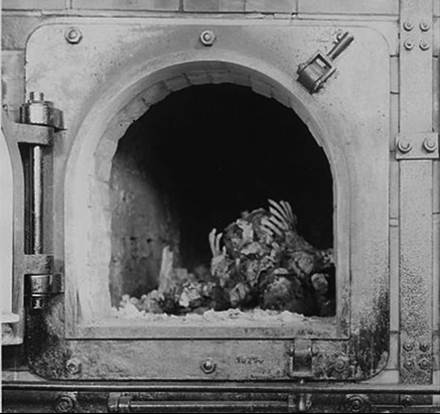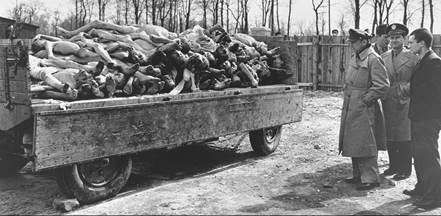The First World War ended in 1918 with the surrender of Germany. The year after, the German government was forced to sign the Treaty of Versailles, which blamed Germany for the war and placed harsh economic sanctions on the country. Back home, however, the surrender had come as a complete surprise, causing many Germans to reject the defeat. Looking for someone to blame, a story began to circulate that the Jews had been responsible for the loss. Adolf Hitler and his Nazi party played into this resentment and also gave Germans a renewed sense of pride, which he communicated with his almost hypnotic speaking abilities to his ever growing following.
After a failed coup attempt, Hitler ended up in prison, after which he decided to use the democratic system to become dictator, which became a reality in 1933. A few years later, he began conquering surrounding countries, plunging Europe into the devastating Second World War.
As part of his horrific vision, he ordered the construction of concentration camps to systematically murder Jews and other minorities. When the Allied forces finally defeated Germany, Hitler killed himself in his bunker before getting caught.
We will trace how this all came to be, in order to understand how a modern society like Germany in the not-so-distant past could sink so rapidly into absolute barbarity.
Hitler’s youth
Many people have looked at the upbringing of Adolf Hitler (1889–1945) in an attempt to understand how he became one of the great evil characters in world history. Although his past cannot sufficiently explain the many great atrocities he committed, it does give some insight into where both his hatred and ambitions came from.
Hitler was brought up in a middle-class family. His relationship with his father, Alois Hitler (1837–1903), was dreadful. Alois was an authoritarian and domineering man with a horrible temper and often clashed with the young Adolf. Tension escalated during his teenage years. Hitler aspired to become an artist, but his father saw no future in that pursuit and instead forced him to attend a technical school. As a result, Adolf developed “an elemental hatred” for school. Hoping for his father to change his mind, Hitler intentionally did poorly in class:
I thought that once my father saw what little progress I was making at the [technical school], he would let me devote myself to my dream. [398]
In his autobiography Mein Kampf, we read that only his history teacher could inspire him, as he frequently spoke about Germany’s heroic past.
Alois died when Hitler was just 14 years old. It is unlikely he grieved much over him. Hitler did have a good relationship with his mother, Klara Hitler (1860–1907). She might have been the only person Hitler truly loved. He carried her picture with him to his last days. After his father’s death, he convinced his mother to call him in sick, so he could stay with her full-time. At home, he spent the next two years drawing, painting, reading, and writing poetry. Already at this stage, he fantasized about becoming a great artist. In these years, Hitler rarely had friends. One exception was August Kubizek (1888–1956), who realized that Hitler “had to speak and needed someone to listen to him,” which August gladly did. [399] Hitler was especially enthusiastic about the composer Richard Wagner, who had brought to life Germany’s heroic and primal mythology in his operas. In his compositions, Wagner often worked out the ideals of struggle, sacrifice, redemption, victory, and heroic death—all concepts that would remain essential to Hitler’s later philosophy. Hitler later claimed that no one could understand his political career without first understanding Wagner. The boys also spoke about great art and architecture. Hitler would lecture his friend on the need to tear down and replace ugly public buildings and even made sketches for the rebuilding plans.
At 17, Adolf convinced his mother to fund him a trip to Vienna, to study the city’s art and architecture. With his father out of the way, he returned to Vienna the next year to study at the Viennese Academy of Fine Arts. He lived there with his friend August, who hoped to enroll in Vienna’s conservatory. According to August, Hitler became very possessive towards him, wanting their friendship to be exclusive. When August brought a girl over for music lessons, Hitler, thinking she was his girlfriend, would explode with rage. Later in his life, Hitler developed a similar obsessive relationship with his niece, whom he showed off and took everywhere, until she eventually shot herself in Hitler’s apartment.
Of the 113 candidates who applied to the art academy, only 28 passed—and Hitler was not among them. Often unrealistically optimistic about his chances, he was “convinced that it would be child’s play to pass the examination.” He later wrote: “I was so convinced that I would be successful that when I received my rejection, it struck me as a bolt from the blue”.[24] [399] Ashamed, he did not tell anyone and hoped for better luck the next year. His friend August did pass the entry exam to the conservatory of Vienna, something Hitler had a hard time dealing with. He had always felt superior to his friend and therefore couldn’t bear losing out to him. The next year, Hitler was rejected for the second time, which devastated him even more. When August returned to their apartment after visiting his parents, Hitler had moved out without telling where he went, likely out of shame.
During this time, his mother contracted terminal breast cancer. Her doctor, Dr. Bloch, later described how caring Hitler was for his dying mother. He even remarked: “I have never seen anyone so prostrate with grief as Adolf Hitler.” [399] After his mother’s death, Hitler soon ran out of money and was forced to live in homeless shelters. This was the start of “an endless bitter time” for Hitler. He sometimes slept in the open, sometimes in shelters, and wore filthy lice-ridden clothes. To make a little money, he shoveled snow, carried bags, and eventually painted touristic scenes of Vienna, which a friend at the homeless shelter would sell for him. Although often hungry, he spent much of the little money he earned on books about art, music, and architecture, and—most importantly—he bought tickets to the opera. In these days, we read, “I had heard [Wagner’s] Tristan thirty or forty times.” [399] About this period of his life, he wrote in Mein Kampf:
For many people the name of Vienna signifies innocent jollity, a festive place for happy mortals. For me, alas, it is a living memory of the saddest period in my life. Even today the mention of that city arouses only gloomy thoughts in my mind. Five years of poverty in that Phaeacian town. Five years in which, first as a casual laborer and then as a painter of little trifles, I had to earn my daily bread. And a meager morsel indeed it was, not even sufficient to still the hunger which I constantly felt. That hunger was the faithful guardian which never left me but took part in everything I did. Every book that I bought meant renewed hunger, and every visit I paid to the opera meant the intrusion of that inalienable companion during the following days. I was always struggling with my unsympathetic friend. And yet during that time, I learned more than I had ever learned before. Outside my architectural studies and rare visits to the opera, for which I had to deny myself food, I had no other pleasure in life except my books. [...] I read a great deal then, and I pondered deeply over what I read. All the free time after work was devoted exclusively to study. Thus within a few years, I was able to acquire a stock of knowledge which I find useful even today. [398]
In time, he upgraded from the cheapest homeless shelters to a slightly better Men’s Home. Here he soon started lecturing his fellow men on politics and art. Fueled by both the opera and local newspapers, he developed strong German nationalistic beliefs. Hitler, like many Austrians, was an ethnic German and felt disdain for the multi-ethnic nature of the declining Habsburg monarchy. He came to believe that all the foreign influences were “corroding […] German culture.” In Vienna, Hitler also became exposed to racist rhetoric. Newspapers at the time openly spoke about racial purity and stoked fears about Jews infiltrating high positions in society. He later wrote: “Wherever I went I began to see Jews, and the more I saw, the more sharply they became distinguished in my eyes from the rest of humanity.” [399]
At 24, Hitler was called up to serve in the army. He illegally avoided the draft in Austria and instead moved to Munich, the capital of the German state Bavaria (“Bayern” in German), where he volunteered for the German Bavarian Army instead. In Munich, he also hoped to gain access to its Art Academy.
World War I
In the years leading up to the First World War, Europe grew increasingly unstable. This was especially apparent in the Balkans, where the Ottoman Turkish Empire was in decline, causing a power vacuum which led to a number of wars for dominance over the region. The situation escalated in 1914 when a Serbian nationalist assassinated Archduke Franz Ferdinand (1863–1914), heir to the Habsburg throne. As a result, Austria-Hungary declared war on Serbia. The conflict quickly spread as countries picked sides. Russia sided with the Serbians. Fearing a war against Russia on their eastern border and France on their western border, Germany preemptively attacked France. Eventually, countries across the world joined in, causing the First World War. Remarkably, news of the war was met with great enthusiasm, as it finally released the tension that had been building in Europe. Crowds gathered in celebration, which has been called the August Madness. The war had the same effect on Hitler. There even is a photograph supposedly showing Hitler joining the festivities (see Fig. 600), although some recent evidence seems to indicate the photo was doctored to serve as propaganda for the Nazi party.
Fig. 600 – Hitler celebrating the start of the First World War, by Heinrich Hoffmann (1914)
Many soldiers looked forward to deeds of heroism, not realizing that the nature of war had changed. Soldiers spent most of their time stuck in wet and muddy trenches, surrounded by barbed wire and decaying corpses (see Fig. 601). Whichever side dared to attack first was often immediately mowed down by heavy artillery. In some cases, after years of war, the front barely moved a few meters. The power of industry had overtaken the skill and bravery of individual soldiers. As a result, most soldiers felt like anonymous pawns instead of heroes. This change was also apparent in their uniforms. Where in previous wars soldiers had worn plumed hats and colorful suits, they now wore camouflaged uniforms and helmets. On top of all this, half the casualties of the war were never identified, making the unknown soldier one of the main symbols of the war. The total death count of the Great War is estimated at 40 million. Given the horrifying conditions, many soldiers developed strong psychological problems, including nervous spasms, confusion, and an inability to follow orders. The condition was called shell shock at the time, but is today recognized as PTSD.
During the First World War, the declining Ottoman Empire committed genocide, systematically killing off an estimated one million Armenians. Hitler later tried to justify his own ruthless massacres by claiming that no one remembered the Armenians:
Who, after all, speaks today of the annihilation of the Armenians? [400]
But the war wasn’t a negative experience for everyone. Hitler claimed that it gave him a sense of purpose and belonging. Even though he had been wounded in his thigh by an exploding shell and had been temporarily blinded in a mustard gas attack, he described it as “the greatest of all experiences”:
I fell down on my knees and thanked Heaven from an overflowing heart for granting me the good fortune of being permitted to live at this time. [399]
Fig. 601 – A French trench at Verdun (1916) (National Army Museum, Britain)
Hitler was stationed in Flanders as a dispatch runner, to deliver messages between front lines. After four days of fighting, the regiment he belonged to was reduced from 3600 to 600 men. He later wrote this showed him “that life is a constant horrible struggle” and it also immunized him against the endless human suffering of war. In the first year of the war, he was awarded the Iron Cross, Second Class, for risking his life protecting a commanding officer. Four years later, on the recommendation of his Jewish lieutenant, he received the Iron Cross, First Class, for bravery shown when delivering an important dispatch through heavy fire, which was rarely awarded to his rank.
Fig. 602 – Hitler (on the far right) sitting among his fellow soldiers (1914-1918) (Deutsches Bundesarchiv, CC BY-SA 3.0 DE)
Hitler’s fellow soldiers would later remark that Hitler received no mail from friends and family and that he often spent his free time brooding or reading. His only real affection at the time was for a dog he had found in the warzone. He always looked forward to meeting the dog when he returned from duty, but one day the animal had disappeared. About this event, he later wrote: “The swine who took him from me doesn’t know what he did to me.” [399]
The Treaty of Versailles
In 1918, Germany experienced heavy losses and had depleted almost all its reserves. As a result, Germany saw no other option but to surrender. Afterward, they were pressured to sign the Treaty of Versailles, which imposed heavy economic sanctions on the country and placed strict limits on their armed forces. The treaty caused great resentment, especially since many Germans didn’t fully believe they had been defeated, for when the surrender took place, the German forces were still fighting and the home front had held out. The disbelief was further stoked by German propaganda, which had only shared positive news about the war. As a result, the Germans were not prepared for capitulation and saw the treaty as an unjust humiliation.
Hitler was also shocked by Germany’s capitulation. He was devastated by the loss, felt intense hatred towards those responsible for the capitulation, and became convinced of his political “mission” to save Germany:
I could stand it no longer. It became impossible for me to sit still one minute more. […] Everything went black before my eyes. […] Since the day when I had stood at my mother’s grave, I had not wept […] but now I could not help it. […] Had all been in vain […] Did all this happen only so that a gang of wretched criminals could lay hands on the fatherland? […] I knew that all was lost. […] In these nights, hatred grew in me, hatred for those responsible for this deed. In the days that followed, my own fate became known to me. […] I, for my part, decided to go into politics. [399]
Looking for someone to blame, conspiracy theorists created the stab-in-the-back myth, which stated Germany had not been defeated but was instead betrayed on the home front by its own leaders—among them a number of Jews (see Fig. 603). Some of these same Jewish leaders also signed the Treaty of Versailles and supported a revolution in 1918 to overthrow the German Empire, replacing it with the democratic Weimar Republic. The signing of the treaty of Versailles immediately discredited the Weimar Republic in the eyes of many Germans.
Fig. 603 – Cartoon depicting the “‘stab-in-the-back myth”’ (1919)
Blaming the Jews fit easily with an already widespread conspiracy, which claimed that they secretly planned for world domination by infiltrating high positions in politics and business. One influential document in support of this worldview was a forgery known as the Protocols of the Elders of Zion (1903), which was presented as a leaked document detailing their supposed plan for world domination. In some versions of the myth, it was believed the Jews would achieve this by rigging the capitalist system, while in other cases, they would use International Communism to control the world (Marx also came from a Jewish family).
The German state of Bavaria, where Hitler resided, first descended into near anarchy after the war, was then followed by a short-lived Soviet-style government populated by various influential Jewish Marxists, and then, after a mini-civil war, the conservative Right gained the upper hand, making Bavaria a magnet for right-wing extremists. Overall, the initial years of the Weimar Republic were highly unstable. Between 1918 and 1923, militant groups on both the Far Left and the Far Right launched at least five unsuccessful coup attempts and right-wing extremists carried out about 350 political assassinations, including the murder of the Reich Finance Minister. Economically, the Weimar Republic was also in big trouble. In 1921, food became eight times more expensive, this rose to 130 times in the next year, and in 1923 it lost all its value due to hyperinflation. The exchange rate at the time was one trillion marks to a dollar. A wheelbarrow full of money would not even buy a newspaper. As a result, people lost their entire savings and pensions.
The NSDAP
In 1919, a small party named the German Workers’ Party (DAP) was established by a group of nationalists. That same year, Hitler, now thirty years old, showed up at one of their meetings as an agent for the army, tasked with investigating new radical political parties in Munich from the Far Right to the Far Left. During his visit, he spontaneously gave a speech and was invited to enroll as a member, which he did. Hitler soon realized he could strike a chord when addressing an audience. For the first time, he found something at which he was an unqualified success. He soon became their star performer, speaking in packed beerhalls, attracting many new members to the party. Hitler’s main message was that there was a way out of Germany’s miserable state. In Wagnerian terms, he presented a quasi-religious vision of redemption for Germany through struggle and sacrifice, all through the application of an unshakable will. In his view, the Germans needed to restore the pride of their glorious past by reversing the betrayal of Versailles, which had turned Germans into near-slaves.
Already at this early stage, Hitler made his first public statement about the “Jewish Question,” ominously referring to a discussion on what to do with the unwanted minority among their midst. In a letter from the time, he went further, stating “the final aim must unshakably be the removal of the Jews altogether.” At the time, he wasn’t yet referring to their mass murder, but instead to expelling them from German territory. Throughout his life, Hitler regularly used language associated with disgust when discussing the Jews. Instinctively speaking, disgust is a reaction to the smell and taste of contaminated food or water. Somehow, Hitler connected this sensation to the Jewish population, which clearly showed in his language. He called them “vermin,” “parasites,” “lice,” “maggots,” “bacteria,” “viruses,” and spoke of “decay,” “contamination,” “decomposition,” “sickness,” “disease,” “infection,” “extermination,” “purity,” “cleansing,” and so on. His use of these words matches strongly with his obsessive personal hygiene. Hitler was a germophobe who often took multiple baths per day and washed his hands compulsively.
Hitler was also a hypochondriac. He suffered from nervous tension, tremblings, and stomach cramps, which he interpreted as the beginnings of cancer (from which his mother had also died). Dramatically, these symptoms made him feel he had only a few years to complete “the gigantic task” he had set for himself. With great tenacity, he concluded: “I must come to power before long. […] I must, I must.” [399]
In 1920, Hitler also wrote a 25-point party program together with Anton Drexler (1884–1942), the founder of the DAP. Among the points we find the denial of Jewish citizenship, regulation of the press, centralization of power, and the aim to reunite all lands with a large ethnic German population into one Greater Germany. Later, Hitler would change his mind on some of the 25 points, but refused to change the document, which he declared “immutable.” When asked about the changes, he claimed the New Testament is also filled with contradictions. It was more its symbolic nature that mattered.
As the years went by, Hitler’s brilliant skills as a public speaker and crowd manipulator only grew. Using his characteristic aggressive speaking style, the strong conviction in his speaking voice, and his domineering presence, he could give his audience the feeling of certainty they had been craving in those dark times. As a result, he soon gathered crowds into the thousands. His speeches effectively gave a voice to the fears, prejudices, and resentment of the Germans like no one else could. To get his message across, he would time and again repeat the same simple ideas, often connecting them to the news items of the day. He would often start his speeches slowly, include plenty of sarcasm and personalized attacks, and as time progressed, build up his aggression, stirring his audiences into a frenzy. Hans Frank (1900–1946), who would later become the Governor General of Poland under Nazi rule, remarked at the Nuremberg trials how he had been entranced as a 19-year-old when listening to one of his speeches:
He spoke over 2.5 hours, often interrupted by frenetic torrents of applause—and one could have listened to him for much, much longer. Everything came from the heart. […] I was convinced that if one man could do it, Hitler alone would be capable of mastering Germany’s fate. [399]
Hitler’s words and eyes had an almost hypnotic effect on his listeners as he managed to channel the deepest fears and desires of his audience. As a member of the Hitler Youth recalled:
We erupted into a frenzy of nationalistic pride that bordered on hysteria. For minutes on end, we shouted at the top of our lungs, with tears streaming down our faces: “Sieg Heil, Sieg Heil, Sieg Heil!” From that moment on, I belonged to Adolf Hitler, body and soul. [401]
The German nationalist Kurt Ludecke had a similar experience:
My critical faculty was swept away. […] He was holding the masses, and me with them, under a hypnotic spell by the sheer force of his convictions. […] His appeal to German manhood was like a call to arms, the gospel he preached a sacred truth. […] I experienced an exaltation that could be likened only to religious conversion. […] I had found myself, my leader, and my cause. [399]
Hitler, the master manipulator of crowds, soon learned that once he had whipped the broad masses into a frenzy, they would turn “blind and stupid” and “primitive in attitude.” After getting them to that point, he realized, he could essentially do with them as he pleased.
Around this time, his followers also began to call him Fuhrer (“leader”), starting what is known as the Fuhrer cult. Newspapers took up this image, portraying Hitler as a special kind of leader—the leader for which Germany was waiting. In one of his speeches, he claimed to feel “the call to Germany’s salvation within him” and saw it as the task of the people to “give the dictator, when he comes, a people ready for him.”
The DAP also deliberately provoked the Left, hoping they would show up at their rallies, to increase publicity for the movement. To defend themselves, they established the Hall Security (Saal-Schutz) which eventually turned into the Stormtroopers, or Sturmabteilung (SA), the paramilitary organization of the party. Hitler also organized a personal body guard, which later turned into the Protection Squad, or Schutzstaffel (SS). After one violent clash with the Left, Hitler was sentenced to three months imprisonment of which he served two months.
At Hitler’s urging, the party was eventually renamed the National Socialist German Workers’ Party (abbreviated as the NSDAP, while National Socialism became shortened as “Nazi”). The word “national” was added to appeal to the nationalist conservatives in contrast to the internationally-minded Social Democrats. The word “socialist” was added to give left-wing voters an alternative to the communist system. This way, Hitler attempted to reach a broad public, promising something for everyone.
Hitler also became strongly opposed to democracy, which was championed by the ruling Social Democratic Party (SPD). Democracy, he claimed, made countries weak and overly individualistic. For the same reason, he opposed the League of Nations with its emphasis on human rights, which he called an “invention of weaklings and fools.” Instead, he intended to create a tightly knit People’s Community (Volksgemeinschaft) in which the individual good was subordinate to the common good. This did not mean communism, however, which Hitler detested. He did not believe in the rule of the proletariat and would later also ban worker’s unions. Instead, he preferred a meritocratic system where achievement, strength, will, and struggle allowed individual genius to thrive. Success, he added, should not be dependent on social class. Anyone should be able to rise from anonymity to prominence using only his “will” (just like Hitler himself had done). Hitler liked the “social Darwinist” nature of capitalism and cautioned against the “bureaucratic managing of the economy,” which impeded the process of natural selection in the market (and, he added, tended to preserve the weak and put a burden on high achievers). To let the system run its course, he would later privatize banks, shipyards, railway lines, shipping lines, welfare organizations, and more. Yet he did demand that businesses worked in the interest of the state. If this was not the case, he was willing to interfere. It was the state that should hold priority and not the wages of workers, the standard of living, or the market. He also denied the necessity of Marxist conflict between the proletariat and the bourgeoisie, believing that his “high ideal” would overcome these social divisions.
During this time, Hitler also designed the party’s banner—a black swastika in a white circle on a red background.
The rise of fascism
The First World War also created instability in Italy. The Italians suffered great losses on the side of the Allies, for which they expected to be compensated by territorial gains. Yet, at Versailles, these gains were denied. This caused much resentment among the Italians, which was cleverly exploited by Benito Mussolini (1883–1945), also known as Il Duce (“the leader”). Mussolini was the founder of a new violent nationalistic movement called fascism, named after his Fasci di Combattimento (“Combat Squads”). His squad wore black shirts and used the Roman salute.
Presented as an alternative to communism and democracy, fascism came to emphasize order, the power of the state, and military heroism, as signified by their slogan: “Believe, obey, fight.” Mussolini claimed that the most important term describing fascism was “action,” which included the possibility of violent revolution. Anti-Semitism and racism were not yet part of the movement, but they were adopted later under Hitler’s influence.
In 1922, the fascist squads marched on Rome to take Italy by force—which was presented as a bold “seizure of power,” exemplary of the Fascist ideology. Behind the scenes, however, Mussolini had already gained the approval of the king of Italy to form a new government. He nevertheless allowed the march to play itself out, celebrating it as a move of “direct action.” Mussolini then became dictator, made his Black Shirts a government body, formed a secret police agency, and suspended elections.
The popularity of Mussolini’s image as a “strong man” and his Fascist style of government soon inspired other countries to follow suit. Fascism became especially popular during the Great Depression (1929–1939) when about 60% of the European nations came to be run by authoritarian governments.
Fig. 604 – Benito Mussolini (Italy)
The Beerhall Putsch
In 1921, inspired by Mussolini’s Black Shirts, the Nazis turned their Hall Security into the SA, also called the Brown Shirts, which came under the leadership of the influential officer Ernst Rohm (1887–1934). Two years later, in imitation of Mussolini’s March on Rome, Hitler launched a march to first overthrow the Bavarian government and then take Berlin. To increase his chances, Hitler first interrupted a speech by Gustav von Kahr (1862–1934) in the Burgerbraukeller, a beerhall that could hold an audience of about 3000 people. Von Kahr was the right-wing head of the Bavarian government. He had turned Bavaria into a haven for right-wing extremists and had declared a state of emergency giving him almost dictatorial powers. This, however, did not mean he was on the side of Hitler. In fact, he had banned NSDAP meetings. Hitler arrived with his stormtroopers in the beerhall, had his men push a machine gun in the hall, and walked in with two bodyguards, who had their pistols pointed at the ceiling. Hitler announced that a national revolution had begun and that the beerhall was surrounded by 600 armed SA men. Once in a back room, Hitler drew a handgun and forced Kahr to take his side. He declared a new Reich government, headed by himself and proposed that Kahr would become head of state. When he returned to the audience, he got the crowd on his side and announced: “Either the German revolution begins tonight or we will be dead by dawn.” Kahr agreed publicly to join Hitler, but revoked the promise once he reached safety.
Rohm succeeded in occupying the Reichswehr headquarters, and others initially captured the police headquarters, but everywhere else they failed. Especially crucial was that the army and state police did not join. The next day, Hitler and his followers marched to the Bavarian War Ministry, but they were soon fired at by the police. Sixteen NSDAP members and four police officers were killed, Hitler was arrested for high treason and sentenced to five years in prison, and the NSDAP was banned once more.
Free speech for Nazis?
It is commonly argued that the Nazis were given too much room to spread their message, but the reality is more nuanced. The party and associated newspapers were regularly banned and Nazis were not permitted to broadcast on the radio. Hitler generally concluded these bans were a net positive, boosting his fame as a martyr. It allowed Goebbels, for instance, to spread posters depicting a muzzled Hitler, presenting him as a victim silenced by the Jewish conspiracy which he was trying to expose. On top of this, all the repressive measures to stop Hitler were later immediately exploited by the Nazis when they came to power, paving the way for dictatorship without having to change the law. Once Hitler took power, a Social Democrat bravely protested, referring to the Enlightenment principle of free speech, but was then easily put in his place by Hitler, since Weimar too had used this principle only when it was in their own favor:
You should have recognized the beneficial power of criticism when we were in the opposition. […] Back then our press was verboten and verboten and again verboten; our assemblies were banned; we were not allowed to speak, and I was not allowed to speak—and that went on for years! And now you say criticism is beneficial! [136]
Mein Kampf
During his trial, Hitler accepted full responsibility for his attempt to overthrow the Weimar Republic and even glorified it. With the judges on his side, he was allowed to wear his suit in court, including his iron cross, and spoke for four hours. He was finally sentenced to just five years imprisonment. Hitler was also treated well in prison. His jail cell looked more like a hotel room. It was a large furnished room, including an easy wicker chair and a large desk. He was also allowed to read the newspaper and could wear his lederhosen. The jailers even secretly greeted him with “Heil Hitler”. Most importantly, Hitler could send and receive letters from party members, and he even invited them over. He also received gifts, flowers, and endless letters of support from the general population. In 1924, after serving just nine months in prison, he was pardoned by the Bavarian Supreme Court and released from jail. The prison staff gave him an emotional farewell.
Fig. 605 – Mein Kampf (1925) (New York Public Library)
His prison sentence did convince Hitler that if he was to gain power in Germany, it was better to commit to legality. His plan was to win the majority of votes, after which he would destroy democracy from the inside out.
In prison, Hitler wrote his autobiography Mein Kampf (“My Struggle”). The work was simultaneously a manifesto, describing his “world-view” (“Weltanschauung”) and “mission.” Over the years, the book would sell millions, making him a rich man. As was typical of his later leadership style, the book did not specify concrete policies, but instead gave his long-term “vision.” Even at the height of his power, he would rarely concern himself with practicalities, day-to-day issues, and administration, but instead aimed at “eternal truth.” His subordinates could fill in the details.
In the book, Hitler described history as an endless racial struggle for “living space” (“Lebensraum”). In line with social Darwinism, he wanted survival of the fittest to weed the failing races out of the gene pool. According to Hitler, the Aryans were the “master race,” with Germans as their purest descendants. In contrast, the Jews were demonized as “untermenschen” (“subhumans”), who had contaminated the German race.
The “legal” route to power
In 1928, during Weimar’s greatest years, the Nazis joined the parliamentary elections for the first time but gained only 3% of the votes. Things started to turn in Hitler’s favor the next year, when Wall Street crashed, starting the Great Depression. Much of the West experienced increased unemployment, bankruptcies, forced sale of land, and widespread indebtedness. Germany, which was already suffering from economic sanctions, was especially hard hit. Hitler could not believe his luck. Playing on the fears of the people and channeling their anger, Hitler’s party grew, with rallies now attracting up to 40,000 people. The cabinet fell in 1930 and in new elections Hitler’s party became the second largest in the country with 18% of the vote. They were the only party with broad support across all layers of society. In another election two years later, they became the largest party but still failed to win a majority. The Center Party politician Franz von Papen (1879–1969) was elected chancellor, the leader of the new government. Unfortunately, he too was hoping for an authoritarian government, backed by the Nazis if necessary.
When formations failed, Paul von Hindenburg (1847–1934), who had been president since 1925 (making him head of the armed forces), called for yet another election in 1933, which had the same result. Having lost twice to Hitler, he reluctantly appointed Hitler chancellor (Reichskanzler). Elated, Goebbels wrote in his diary, “Hitler is Reich Chancellor. Just like a fairy tale.” Von Papen and Hindenburg had hoped to contain Hitler, but they were quickly proven wrong.
Due to their election victory, the influential Nazi Hermann Goring (1893–1946) effectively became in charge of the police in Prussia, by far the largest state in Germany. The police were forced to work together with SA and the SS. Meanwhile, Nazi mobs were allowed to commit atrocities, while Hitler pretended these mobs acted against his will.
That same year, 1933, the parliament building known as the Reichstag was set on fire by a Dutch communist named Marinus van der Lubbe (1909–1934). In response, the Nazis stoked fears of a communist uprising, based on which Hitler urged Hindenburg to issue the Reichstag Fire Decree, which gave the government emergency powers to protect the public, including detention without trial and it also ended free speech. With this power, Hitler arrested some 4000 members of the German Communist Party.
Fig. 606 – Paul von Hindenburg (1933)
Later that year, Hitler convinced Hindenburg to schedule yet another election, which won him 44% of the votes, again necessitating a coalition. Tired of sharing power, he then brought the Enabling Act to a vote, which gave the government the power to enact laws without the consent of the Reichstag for four years, transforming Hitler’s government into a de facto legal dictatorship. Since this law required an alteration of the constitution, it required a two-thirds majority to pass. Making sure he would succeed, he used the Reichstag Fire Decree to arrest all 81 Communist members of parliament. The Reichstag met in a room covered in swastika banners, with armed SA and SS guards at all exits. The Center Party decided to vote in Hitler’s favor, in exchange for promises the Nazis would soon break. The government then voted itself out of existence with 441 to 94 votes.
With full control over the government, Hitler began to suppress the remaining opposition. The Social Democratic Party was banned and its assets were seized, all trade unions were forced to dissolve and their leaders were arrested, Jews were dismissed from civil service and Jewish doctors were taken out of the national insurance scheme, and books of “unacceptable” authors were burned. The “Law Against the New Construction of Parties” left the NSDAP as the only remaining party and the “Heil Hitler” salute became compulsory for civil servants.
In 1934, Hitler feared that the SA was becoming too impatient with his slow legal route to power. He also feared he could no longer control the organization. Especially the ambitions of Ernst Rohm were worrisome. Rohm wanted the SA in charge of Germany and was privately critical of Hitler. As a result, Hitler wanted the organization out of the way. Conveniently, Hindenburg at that time also called on Hitler to restrain the SA. To get this done, he spread false messages of a planned SA coup, including a fake order by Rohm to attack the Reichswehr. He then had top SA members arrested as a preventative measure. Hitler personally met with local Bavarian SA leaders, ripped off their badges and shouted: “You are under arrest and will be shot.” He next moved against Rohm himself. He stormed in with a pistol in his hand, denounced him as a traitor, and placed him under arrest. Six other SA leaders in the room were shot without trial. They were simply told before their deaths: “You have been condemned to death by the Fuhrer! Heil Hitler!” [399] Rohm was given the option to take his own life, for his many past services to the party, but when he refused to shoot himself, he too was killed. The purge of the SA took the lives of between 150 and 200 men in what came to be known as the Night of the Long Knives. There were also victims not associated with the SA. For instance, Von Kahr was dragged away by SS men and later found hacked to death. The previous chancellor, Kurt von Schleicher (1882–1934), was also murdered. Perversely, these brutal illegal killings were welcomed even by his political opponents. Hindenburg expressed “deep-felt gratitude” for the “resolute intervention” which “rescued the German people from serious danger.” [399]
In 1934, President Von Hindenburg died. Just before, Hitler had passed a law that would combine the office of Chancellor with the office of President after his death. As a result, Hitler became both head of state and head of the armed forces, under the title “Fuhrer und Reichskanzler.”
Not long after, Hitler took Germany out of the League of Nations and out of disarmament talks, but he was also careful not to upset the international community too much while Germany was still militarily weak. In his speeches from that time, he did his best to soothe their worries. He stressed the legality of his actions, the peaceful goals of his policies, and his willingness to work within international agreements.
Fig. 607 – Hitler receiving an ovation on the evening of his inauguration as chancellor (Deutsches Bundesarchiv, CC BY-SA 3.0 DE)
Meanwhile, Hitler also sought to modernize Germany by offering Germans a new quality of life. He promoted the creation of the Volkswagen (“People’s Car”), which gave ordinary Germans the prospect of owning a car, and he helped build Germany’s famous Autobahn network.[25] He also invested in better housing, created a welfare system, and subsidized holidays to make them available to the masses. In the early years of his rule, Hitler seemed to deliver. In 1936, he announced a Four-Year Plan, in imitation of Stalin’s Five-Year Plan, which led to full employment in 1939 and a recovered economy, which Hitler called the “German economic miracle.” By that time, his regime looked strong and stable. As a result, the Nazis had high approval ratings, estimated between 80 and 90%. Although impressive on the surface, the economic “success” was mostly achieved through deficit spending which was invested primarily in the military industry. The Nazis gambled they would eventually repay their debt by plundering the wealth of conquered nations.
The Third Reich
Hitler called his new Germany the Third Reich (“Third Empire”), presenting it as the successor to the two German-centered empires —the Holy Roman Empire (962–1806) and the German Empire (1871–1918). To further convey the deep historical roots of his project, Hitler ordered architect Albert Speer (1905–1981) to design a grand building program for Berlin in a neo-classical style. To simultaneously channel the unparalleled modernization that Hitler foresaw for his new order, the classical designs were stripped of their ornamentation. The result conveyed not only simplicity but also strength, uniformity, and monumentality (see Fig. 609 and Fig. 608). The new buildings were also meant to convey a sense of eternity as Hitler was designing his Third Reich to last for a thousand years. These buildings were to become his lasting monument to the world, but ironically, Germany fell before the project in Berlin even started.
Fig. 608 – Hitler looking at architectural designs by Albert Speer for the world fair in Paris. (1937) (Süddeutsche Zeitung)
Fig. 609 – Architectural design plans for Berlin by Albert Speer, including the huge Volkshalle dome (1939) (Deutsches Bundesarchiv, CC BY-SA 3.0 DE)
Speer did create the Zeppelinfeld stadium in Nuremberg. During Nazi Party rallies, he turned it into the Cathedral of Light, consisting of 152 anti-aircraft searchlights aimed skyward to create a series of vertical columns surrounding a huge square (see Fig. 610).
Fig. 610 – The Cathedral of lights and the Zeppelinfeld stadium, designed by Speer (1936) (Deutsches Bundesarchiv, CC BY-SA 3.0 DE)
Goebbels, Minister of Propaganda
The regime also used a highly advanced system of propaganda, which became institutionalized in 1933 with the establishment of the Ministry of People’s Enlightenment and Propaganda, led by the propaganda mastermind Josef Goebbels (1897–1945). Goebbels had been bullied as a child and felt inadequate throughout his life because of a deformed right foot. On top of this, he developed deep resentment when his attempts to become a writer led to nothing. In his famous diary, he indulged in self-pity about his early failures, even quoting Jesus, stating: “My God, my God, why hast Thou forsaken me?” As a result, he felt especially grateful when Hitler recognized his talent. In his diary, he claimed Hitler was to him “like a father.” In his eyes, Hitler was an almost messianic figure who deserved his complete devotion and loyalty:
Who is this man? Half plebeian, half God? Actually Christ, or only John [the Baptist]? […] This man has everything in him to become a king. The born tribune of the people. The coming dictator. […] I love him. [399]
Similar to Stalin, Goebbels regularly presented the people with a utopic vision of German society in which all citizens worked together in a classless volksgemeinschaft (“people’s community”). Also in imitation of Stalin, the Nazis produced millions of volkssender (“people’s radios”) and thousands of public loudspeakers, allowing the booming voice of Hitler to be heard throughout the nation. Special attention was also given to indoctrinating the young. Boys became part of the Hitler Youth and girls of the League of German Maidens. Book burnings sought to undermine the intellectual traditions of Jews, communists, and liberals.
Both Hitler and Goebbels also saw great propaganda potential in film. In 1935, Leni Riefenstahl (1902–2003) directed Triumph of the Will, which chronicles the 1934 Nazi Party Congress in Nuremberg, attended by more than 700,000 Nazi supporters. Its overriding theme is the return of Germany as a great power with Hitler as its leader. The film was internationally recognized as a masterpiece and pioneered techniques using moving cameras and aerial photography. In 1940, Goebbels produced the nauseating anti-Semitic film Der Ewige Jude, which depicted the Jewish race as a people who lived in filth. During the war, he produced Kolberg, for which he withdrew 190,000 soldiers from active service to star in the movie. Both Hitler and Goebbels were convinced that the psychological effect of the movie “was more useful than a military victory.”
Goebbels also created a personality cult around Hitler, depicting him as the infallible Fuhrer of the Third Reich and savior of Germany. Goebbels deliberately used religious imagery and language to describe both Hitler and the Third Reich, hijacking the brainwashing power previously associated with religion. The strong image of Hitler was also appealing to many women, for whom he was a sex symbol. To strengthen this appeal, Hitler deliberately kept his mistress, Eva Braun (1912–1945), out of sight.
To make it seem Hitler was in touch with the common people, he was shown kissing the hands of ladies, giving chocolate to children, shaking hands with peasants and workers, and so on. Iconic was his firm and unusually long handshake, combined with strong, unblinking eye contact. Even leading figures were impressed by it, and many people remarked they would never forget it.
Fig. 611 – Josef Goebbels, by Heinrich Hoffmann (1933) (Bundesarchiv, CC-BY-SA 3.0 DE)
Greater Germany
In 1935, Mussolini invaded Ethiopia, following ancient Roman example. The League of Nations condemned the action but placed only weak sanctions on Italy, exposing its inability to secure peace. One year later, bolstered by Italy, Hitler remilitarized the Rhineland in violation of the Treaty of Versailles. He also expanded the army to six times the permitted size and developed an illegal air force, named the Luftwaffe. The League of Nations condemned his actions but did nothing to stop him. As usual, Hitler flipped the story on its head, claiming the Germans did not want war, nor surpass their enemies in strength, but just sought to ensure peace through self-protection. Britain was willing to go along with this reasoning.
Fig. 612 – A Nazi ceremony at Nuremberg (1934) (Bundesarchiv, CC BY-SA 3.0 DE)
In 1936, Germany also hosted the Winter Olympics, which gave Germany an opportunity to show off to the world. It was an enormous propaganda success, leaving most visitors and viewers impressed. To not upset foreigners, violence against Jews was temporarily halted.
But Hitler had no intention of keeping the peace. Even in Mein Kampf, he had openly written on the first page that “German-Austria” had to “return to the great German mother-country,” as “one blood demands one Reich.” This idea was part of his wish to reestablish Greater Germany, which included all foreign land populated by ethnic Germans. His first victim was Austria, his home country. In 1938, he met with Kurt Schuschnigg (1897–1977), the chancellor of Austria. To make Germany seem like the wronged party, he accused the Austrians of treason for suppressing Nazi activity in their country. Hitler gave Schuschnigg an ultimatum to end all restrictions on the Austrian Nazi party, grant amnesty for arrested Nazis, and demand that the Nazi Arthur Seyss-Inquart (1892–1946) be appointed Minister of the Interior. Otherwise, he claimed, he would march into the country with his army. The chancellor reluctantly caved under the pressure. But as usual, giving in to Hitler only meant he came with even more demands. He now asked Schuschnigg to resign, to make place for Seyss-Inquart. Schuschnigg agreed to resign to avoid bloodshed, but could not bring himself to appoint a Nazi as chancellor. When Hitler gave the Wehrmacht the order to march, the Austrians caved once more and made Seyss-Inquart chancellor, but even with all demands met, Hitler still persisted. He took the country without resistance. The result was the Anschluss¸ or “union,” between Austria and Germany. With Nazi support high among the Austrian population, Hitler was received in his home town Linz and later in Vienna by cheering crowds. Again, the international community did not intervene.
Later in the same year, Hitler turned his focus to Sudetenland, a part of Czechoslovakia with many ethnic Germans. Hitler claimed these Germans were oppressed by the Czech government and its citizens, giving Hitler a reason to invade the area. Deviously, he claimed to be fighting a defensive war for German freedom against Czech oppression. In private, however, he admitted that he did not care about the Sudeten issue and had used it only as an excuse to take over the country. As in the Austrian case, Hitler then made demands the country couldn’t possibly meet. He demanded autonomy for Sudeten Germans and German regiments within the Czech army. When Britain learned of an upcoming invasion by the Germans, they did nothing to stop Hitler and instead pressured the Czechs to give up Sudetenland to keep the peace.
Worried about escalation, the British Prime Minister Neville Chamberlain (1869–1940) met up with Hitler at the infamous Munich Conference (1938), along with the French President Daladier. In an attempt to avoid another world war, Britain and France gave in to Hitler’s demand for the area, allowing it to be occupied by German troops. Chamberlain took Hitler at his word that he had no further territorial demands once the Sudeten problem was resolved. Fooled by Hitler, he returned home, where he declared “peace for our time” (see Fig. 614). Hitler rightly interpreted the reluctance of Britain and the League of Nations as a weakness and planned to occupy the rest of the Czech Republic as well, making a mockery of the international peace negotiations. He upped his demands on Czechoslovakia and then threatened to bomb Prague if these demands were not met. The Czech President finally gave in, offering up the entire country without bloodshed.
Fig. 613 – Chamberlain, Daladier, Hitler, and Mussolini at the Munich Conference (1938) (Deutsches Bundesarchiv, CC BY-SA 3.0 DE)
Fig. 614 – Neville Chamberlain proudly showing the Anglo-German Declaration back home. (1938) (Imperial War Museum, Britain)
The takeover of Czechoslovakia did wake Britain up. It finally became clear that Hitler could never be trusted and would stop at nothing. To prevent Germany from expanding further, England and France guaranteed their alliance with Poland. Convinced it was another bluff, Hitler now sought reasons to justify an invasion of Poland. He stirred up and sometimes manufactured incidents perpetrated by Poles against ethnic Germans. At one point, a “Polish” assault on a German radio station was staged using SS men dressed in Polish uniforms to carry out the attack. A number of concentration-camp inmates were killed and carried to the sites as “victims.” He then made an agreement with the Soviet Union to take over Eastern Europe and split up the territory between them. This alliance shocked the world as Hitler had always been strongly opposed to communism and the Jewish Bolsheviks in the Soviet government. But Britain and France kept their word and declared war on Germany when Hitler invaded Poland, starting the Second World War.
To overcome the immobility of trench warfare that had plagued World War I, Hitler chose a strategy called blitzkrieg (“lightning war”). Tanks and airplanes would act in unison to quickly and decisively annihilate the enemy. The newly conquered land would then provide Germany with new resources to fight the next war. With this strategy, Poland was overrun within a month.
After their surrender, Hitler sent in the Einsatzgruppen (“deployment groups”), the death squads of the SS who operated under the leadership of Heinrich Himmler (1900–1945) and Reinhard Heydrich (1904–1942). Their goal was to “decapitate” Polish society by murdering intellectuals, political leaders, clergy, and Jews, killing an estimated 60,000 people. Unrestricted by German law and order, they used Poland as the “experimental playground” for their radical vision of a “purified” Greater Germany. Unlike the more disorganized Nazi mobs, the SS preferred a “rational” systematic approach to the “Final Solution to the Jewish Question” (“Endlosung der Judenfrage”)
Part of Poland, known as the General Government, was designated as a “dumping ground” for Jews. It was deliberately not made part of the Reich, so that German laws would not apply. Polish citizens were also mistreated. In Nazi estimation, the Poles were only slightly better than the Jews. The Nazi minister Rosenberg called them “dreadful material,” claiming that if “Poland had ruled for a few decades over the old parts of the Reich, everything would be lice-ridden and decayed.” As a result, there was no interest in assimilating the Poles within the Reich. They too, it was believed, should eventually be pushed into the General Government.
Within German borders, the violence against Jews also escalated. In 1938, Jewish homes, businesses, and synagogues were attacked by Nazi mobs in what came to be known as the Kristallnacht (“The Night of the Broken Glass”). During this night, hundreds of Jews were arrested, injured, and killed by both the SA and German civilians, while the police was told to stand down. The Nazi government claimed that the acts of violence had happened spontaneously, but no one believed this. Goebbels diary later revealed it was explicitly approved by Adolf Hitler himself.
Not long after, 30,000 Jews were deported to the first concentration camp in Dachau, with the goal of later deporting them outside German territory. Some suggested sending them to Madagascar, others to Palestine, or even the most barren parts of Russia, but the plans were continuously delayed because they were logistically complicated, especially during wartime.
Hitler’s leadership style
Hitler’s orders were often unsystematic and deliberately vague. He generally declined to pick sides when there was political disagreement within the party, placing himself above day-to-day discussions, which gave him the illusion of infallibility. In many instances, he would only sign a bill once agreement was reached on it, usually scarcely bothering to read it. Sometimes, he would even assign the same task to multiple people or simply refuse to make a decision on an important matter. As he did promote his men based on his satisfaction with their work, his subordinates simply did what they thought was best in line with Hitler’s vision, which the historian Ian Kershaw has called “working towards the Fuhrer.” He got this phrase from a member of the Prussian Ministry, who explained:
Very often […] individuals […] waited for commands and orders. […] It is the duty of every single person to attempt, in the spirit of the Fuhrer, to work towards him. Anyone making mistakes will come to notice it soon enough. But the one who works correctly towards the Fuhrer along his lines and toward his aim will in future […] have the finest reward of one day suddenly attaining the legal confirmation of his work. [399]
This unusual method did have some beneficial consequences for Hitler as his generals would attempt to outdo each other in finding the most radical solutions to realize Hitler’s vision. For instance, the Nazi leaders in Poland vigorously competed to be the first to fully remove Jews from their region. However, it is unclear whether Hitler’s “bureaucratic Darwinism” was a deliberate tactic or not.
The Second World War
In 1940, Hitler attacked France. He admitted it was a huge gamble, as Germany was not yet ready economically and militarily for war. But things went in their favor and they defeated France in just six weeks. When Hitler entered Paris, he spent a day sightseeing accompanied by Speer. According to Goebbels, he found much disappointing and even considered destroying the city, but refrained from doing so believing Berlin would soon outdo Paris. Soon after, Hitler also took Scandinavia and the Netherlands.
Hitler initially hoped for peace with Britain, but when this was rejected, the Nazis launched air assaults on the country. The Germans bombed Royal Air Force bases, radar stations, and also systematically bombed various cities, especially London, hoping this would demoralize the British. They particularly targeted cultural sites for added psychological damage, hoping this would eventually convince Britain to seek peace. But the British did not yield and bravely fought back, defeating the Luftwaffe in a series of air battles known as the Battle of Britain. Initially, there had also been plans for a ground invasion of England, known as Operation Sealion, but this proved unfeasible.
Fig. 615 – Hitler visiting Paris (1940) (Deutsches Bundesarchiv, CC BY-SA 3.0 DE)
Fig. 616 – Airplanes from the British Royal Air Force, by B. Daventry (1940) (Imperial War Museum, Britain)
In 1941, Hitler turned on Russia, launching Operation Barbarossa—the largest invasion in history with 3.5 million men. The blitzkrieg strategy started successfully, allowing Hitler to conquer large parts of the Soviet Union in a matter of days, but a number of crucial mistakes would eventually cause Germany’s downfall. Hitler had intended to invade before June to avoid the Russian winter, but he had to postpone multiple times due to bad weather and to assist Mussolini, who had failed to capture Greece. The delay allowed Russia to mobilize more men and start a counteroffensive, which ended the blitzkrieg phase of the war. To better assist the army, Hitler moved to the Wolf’s Lair, a bunker in Poland with rooms large enough for military conferences.
As winter set in, the Russians gained the advantage, being far better equipped against the snow and the cold. The German soldiers even had a shortage of winter clothing, causing many Germans to suffer horrible cases of frostbite. The Germans did manage to get through the winter, although with heavy losses. Hitler believed it was only his strength of will that got them through it.
Fig. 617 – German soldiers west of Moscow (Wilhelm Gierse, CC BY-SA 3.0)
Hitler made a major blunder when he called back an army heading for Moscow to aid in the encirclement of Leningrad (now St. Petersburg), giving Moscow more time to build up their defenses. His generals protested, but as usual, Hitler refused to listen. Later, he also made the mistake of ordering his troops to encircle Stalingrad and capture the Caucasus oil fields at the same time, while he had earlier agreed to capture them one by one. General Halder found Hitler’s interference in military command unendurable. He wrote in his diary: “No other than the Fuhrer is to blame for the zigzag course caused by his successive orders.” In many cases, Hitler also prevented sensible tactical withdrawals of his armies, mostly because he did not like to be proven wrong. In multiple instances, this led him to destroy his own armies by demanding they hold the line till the last man. Generals who objected were regularly met with explosions of rage and were called disloyal, liars and traitors. In various cases, he removed dissenting generals from their position or even sentenced them to death.
The greatest mistake happened during the second winter at the Battle of Stalingrad. The 6th army of General Paulus was about to be encircled and asked Hitler permission to retreat, but as usual, Hitler told them to hold. Not long after, his army of about 250,000 soldiers was indeed surrounded. On multiple days, Paulus asked Hitler permission to break out, but Hitler instead promised to resupply his army with air supplies. After days and days, Paulus eventually requested permission to surrender, which was also rejected. Instead, he received a telegram stating his army had made a historic contribution to the greatest struggle in German history. The army was to stay put “to the last soldier and the last bullet.” [399] When Paulus finally surrendered, Hitler lost all respect, believing he should instead have shot himself.
Because of his explosive tirades, it became more and more difficult for his subordinates to bring negative news. In many cases, they refrained from doing so, cocooning Hitler from reality. This resulted in even more catastrophic mistakes. Near the end, he was even giving orders to battalions that no longer existed.
Mussolini’s invasion of Russia also failed, after which the king of Italy had him arrested. His replacement signed an armistice soon after. When this became public, the Germans invaded Italy to retain the territory. In 1943, Mussolini was rescued by the Nazis from a ski hotel in an extraordinary raid by parachutists and SS-men carried in by a glider. He was then put in charge of a German puppet state called Republic di Salo in Northern Italy. Two years later, he was captured by Italian communists, who executed him by firing squad and hung his body upside down in Milan for the public to see.
Also in 1943, Goebbels gave his most famous speech, in which he advocated for “total war,” giving him control over the entire home front to maximally mobilize it for war. Goebbels was beside himself with joy when he got the promotion, boasting to his staff that it gave him “practically full dictatorial powers.” In his speech, Goebbels also made the first public admission that Germany was facing serious opposition. He urged the German people to stick with it no matter how long and difficult the war effort would be, as the survival of Germany was at stake.
Fig. 618 – Delivering of cargo three days after D-Day (1944) (U.S. Federal Government)
In 1941, Japan launched a surprise air attack on Pearl Harbor in Hawaii, which forced America into the war. Together, the Western Allied armies invaded Normandy in Northern France in 1944, known as Operation Overlord. The first stage of the invasion was called Operation Neptune, commonly known as D-Day. An armada of 3000 British, American, and Canadian vessels landed on the Normandy coast. The casualty rate was immense, but at the end of the day, 156,000 troops had landed. They then managed to make contact with 13,000 American and British parachutists who were dropped behind the flanks of the enemy lines several hours before landing.
Fig. 619 – D-Day (1944) (U.S. Federal Government)
Hitler’s defeat
With failure after failure, many Nazi officers came to believe that following Hitler’s orders would result in the complete destruction of Germany. In an attempt to stop him, numerous plans were made to assassinate him, but they all failed. An early attack was executed in 1939 by an ordinary German named Georg Elser (1903–1945), who placed a bomb in one of the pillars of the Burgerbraukeller. Eight people were killed when the bomb exploded, but Hitler had just left. On another occasion, in 1943, two bottles of what appeared to be cognac were sneaked on board his plane and assembled into a bomb, but the bomb did not go off. At yet another time, a bomb was placed in an exhibition hall, but Hitler rushed through it too quickly, in fear of air strikes. In each of these cases, Hitler had been extremely lucky.
The closest his opponents came to his assassination happened in 1944. A plan was made by Claus von Stauffenberg (1907–1944) to assassinate Hitler by placing a bomb in a suitcase in a conference room in the Wolf’s Lair. Von Stauffenberg asked to sit close to Hitler because of his hearing disability and then made excuses to leave the room. The bomb went off, but Hitler miraculously only suffered superficial injuries. Von Stauffenberg and his allies, assuming Hitler was dead, attempted a coup. When Hitler discovered this, he ordered savage reprisals for anyone associated. Many were shot without trial, while others were “hanged, hung up like meat carcasses.” After all these lucky escapes, Hitler concluded that Providence had saved him. On the radio he remarked: “It is a sign of providence that I must continue my work, and therefore will continue it.” [399]
Fig. 620 – The destroyed room at the Wolf’s Lair after the assassination attempt on Hitler (1944) (Deutsches Bundesarchiv, CC BY-SA 3.0 DE)
While chances of a German victory were getting less likely by the day, Hitler, at least to the outside world, maintained his unreasonable optimism. With little concrete to be positive about, he instead held on to the belief that Providence would bring him a miraculous salvation. “It is impressive,” Goebbels wrote, “with what certainty the Fuhrer believes in his mission.” [399]
He did have some final hopes. The famous aircraft designer Professor Willy Messerschmitt (1898–1978) had designed the Me262 airplane, which could outfly any enemy aircraft, but Hitler overestimated the speed with which they could be produced. Hitler also insisted that the Me262 should be used as a bomber, even though this wasn’t technically possible. When Hitler later discovered his orders were ignored, he exploded in fury. Hitler was similarly too impatient with the production process of the long-range rockets V2, which could enter the stratosphere, and the V-1 flying bombs, which he hoped would finally bring Britain to its knees. Eventually, the flying bombs were shot at London, causing great damage, but the British would not give up.
At the beginning of 1945, Hitler retreated to the Fuhrerbunker in Berlin under the garden of the Reich Chancellery, which had been partly destroyed by bombings. Initially, he would go up during the day to work in an undamaged part of the Chancellery, but eventually he stayed underground most of the time, losing almost all sense of night and day. He would only see daylight when he needed some fresh air, to let his dog Blondi out in the garden, or for an occasional lunch with his secretaries.
Stressed by years of war, Hitler had aged quickly and his already frail health worsened considerably. He barely slept and as a result was chronically tired. He also walked with a stoop, had a worsening heart condition, chronic stomach and intestinal problems, and onset Parkinson’s. His doctor, Dr. Morell, prescribed a stunning 28 pills each day. These pills included cocaine and oxycodone, which some have claimed can explain his delusional optimism. [402] In the end, his ability to lead his country was also impaired. More than usual he was unable to make decisions, while at the same time he was not willing to concede authority.
Even when the Russians were closing in on Berlin, Hitler still had optimistic moments. For days, he held high hopes for a counteroffensive, but he later learned the attack hadn’t even occurred, causing him to thunder insults through the bunker. He screamed he had been betrayed by all he trusted. At this point, he told his men for the first time that he thought “the war is lost,” but not much later he regained his composure.
As a distraction from all the stress, he would often delve into his architectural plans. When the architect Hermann Giesler (1898–1987) was in Berlin, Hitler would join him twice a day to discuss how his home-town Linz would be rebuilt after the war.
In a radio broadcast in January 1945, Hitler addressed his people for the last time, still calling on them to persevere:
However grave as the crisis may be at this moment, it will, despite everything, be mastered by our unalterable will, by our readiness for sacrifice and by our abilities. [403]
In private, he told his generals that if defeat would come, this was “caused by the weakness of the people,” who therefore had no right to survive into the future:
If the German people turned out to be weak, they would deserve nothing else than to be extinguished by a stronger people; then one could have no sympathy for them. [399]
If not victory, he claimed, the only other option was the complete destruction of Germany, as he would never agree to another capitulation, as had happened in 1918. As a result, he issued the Nero Order, which called for the destruction of all German industrial infrastructure before it could fall into Allied hands. Albert Speer, who at that time was (surprisingly) named Minister of Armament, was entrusted with this task, but he secretly disobeyed the order. Speer did take a dangerous flight into Berlin to say goodbye to Hitler during his final days.
On his 56th birthday, Hitler made his last trip from the Fuhrerbunker to the garden, where he awarded Iron Crosses to twenty boy soldiers of the Hitler Youth who had distinguished themselves in battle and who were now joining the fight to keep the Red Army from entering Berlin. Hitler muttered a few words to them, patted one or two on the cheek, after which they were sent back to fight the Russians
After forming a small and underequipped military unit, Hitler ordered a last offensive to save Berlin. When he later discovered that the attack had not been launched and the Soviets had entered Berlin, he launched into another tirade against his commanders, which he ended with the declaration that “everything was lost.”
Meanwhile, Hermann Goring (1893–1946), the head of the army, sent a telegram to Hitler, asking permission to assume leadership of Germany while Hitler was isolated in Berlin and was no longer giving orders. Considering his request an act of treason, Hitler responded by having Goring arrested. When he discovered that Heinrich Himmler (1900–1945), head of the SS, was trying to negotiate a surrender, he also ordered his arrest, accusing him of treason. In another explosion of fury, he yelled out how even his “loyal Heinrich” could have betrayed him.
Several times, people tried to convince Hitler to move to a safe location, but he was determined to stay in Berlin to “defend the city.” When others couldn’t wait to leave the bunker, Hitler was disappointed, but did not prevent them from leaving. Goebbels emerged as Hitler’s most loyal follower. He chose to spend his last days with Hitler in the bunker, together with his wife Magda and his six children. At some point, he read Hitler some passages on Frederick the Great overcoming great odds, which made Hitler’s eyes fill with tears. But in reality, Goebbels had long believed that defeat was imminent. Convinced that Nazi Germany was about to fall, he wrote in his usual apocalyptic style:
When we depart, let the earth tremble! [404]
With his end drawing closer, Hitler finally decided to marry Eva Braun in his bunker. He also left a final testament, in which he announced that his hatred for the Jews would rise again:
In these three decades, my life and all my thoughts and deeds have been motivated solely by my love for and loyalty to my people. They gave me the strength to make the most difficult decisions that have ever confronted mortal man. In these three decades I have exhausted my time, my working strength, and my health.
It is not true that I or anyone else in Germany wanted the war in 1939. It was desired and instigated exclusively by those international statesmen who were either of Jewish origin or who worked for Jewish interests. [...] I have furthermore never wished that after the first disastrous world war a second should arise against England, much less against America. Centuries will pass away, but out of the ruins of our cities and monuments the hatred will continually grow anew against the people that is ultimately responsible, and for whom we have to thank for all this: international Jewry and its helpers! [405]
He added that his struggle would go down “as the most glorious and valiant manifestation of a nation’s will to existence” and hoped that others would continue his struggle in the future. He then wrote that Goring and Himmler were to be expelled from the party and appointed Donitz the new head of state and of the armed forces.
The day after, with the Soviets closing in, Hitler shook hands with his generals, servants, and guards and thanked them for their service. He then retreated and shot himself in the head, while Eva Braun bit into a cyanide capsule. He had asked for their bodies to be burned so they would not fall into enemy hands. In his testament, Hitler had appointed Goebbels Reich chancellor, but Goebbels saw no point in living without Hitler, claiming, “if the Fuhrer is dead, my life is meaningless.” He said he would “lose all self-respect [if he would] leave the Fuhrer alone in his hour of greatest need.” He arranged for his children to be given morphine and then a cyanide pill when asleep. Afterward, both Goebbels and his wife also took cyanide.
Donitz’s regime was doomed from the start and he quickly surrendered. Himmler took poison when he was discovered by the Allies. Goring found a way to commit suicide during the Nuremberg Trials, while ten other top Nazis were hanged. Speer received only twenty years of jail time, after which he became a best-selling writer.
The Holocaust
During the early stages of the war, it became more and more difficult for Jews to retain anything resembling a normal life. The majority of Jewish firms had been liquidated, Jews were not allowed in public parks and had special train compartments, and they also had to wear a badge with the yellow star of David to be recognizable in public. But things were about to get much worse.
The leader of the SS, Heinrich Himmler, and his deputy, Reinhard Heydrich, were appointed to carry out a program known as Entjudung (“Removal of Jews”). The purpose of this program was to “cleanse” Germany of Jews by deporting them to the General Government. In 1942, Heydrich called a secret meeting, the Wannsee Conference, to further work out this plan. During this diabolical meeting, Heydrich made plans to put the Jews to work in local work camps until they could be sent to the General Government.
A year earlier, however, another more rigorous and ominous solution was already underway—with the creation of the first death camp. The way for this was paved by an earlier “euthanasia” program called Aktion T4 under the leadership of the SS member Viktor Brack (1904–1948), in which an estimated 300,000 incurable, disabled, and mentally ill patients were systematically killed. In line with Social Darwinism, the Nazis believed that weeding out the weakest links increased the strength of their race. Even thousands of children were killed for this reason. Many were shot, but in search for a more efficient way of killing, they also designed gas vans to kill their victims with carbon monoxide gas. In 1941, one year before the Wannsee Conference, the same gas vans were already deployed in the Chelmno death camp. One year later, gas chambers became operational in Belzec, followed by Auschwitz in the same year.
Strangely, Hitler at the time still spoke of the deportation of Jews and not their mass murder. In fact, there is virtually no evidence directly linking him to the Holocaust. This was by design, as Hitler avoided committing himself to paper on the matter, believing the German people were not ready to learn about the full extent of their barbarism. Instead, he carefully used euphemisms, such as “the Final Solution.” The use of this secretive language was explicitly referred to by Himmler, who called their treatment of the Jews “the never to be written glorious page of our history.” [399]
But there is indirect evidence from other Nazi leaders linking Hitler to the Holocaust. Himmler explicitly claimed he operated under Hitler’s authority when executing his genocidal policies and spoke to him about the gas vans. SS officer Heinz Linge claimed Hitler even showed direct interest in the development of gas chambers. Himmler also sent Hitler reports on the “Final Solution of the Jewish Question” which estimated 363,000 Jews had been executed.
Himmler himself did speak frankly about killing Jews. In two horrifying speeches to party leadership, called the Posen Speeches, he was very explicit about what was going on. The transcripts of both speeches were authorized by Himmler himself and the first speech even has an audio recording. He said:
We face the question: what to do with the women and children? I decided here too to find a completely clear solution. I did not regard myself as justified in exterminating the men—that is to say, to kill them or have them killed—and to allow the avengers in the shape of the children to grow up for our sons and grandchildren. The difficult decision had to be taken to have this people disappear from the earth. [399] For the organization which had to execute this task, it was the most difficult which we had ever had. It was carried out without, as I believe I can say, our men and our leaders suffering any damage to their spirit and soul. This danger was very close. The path between the two existing possibilities here, either becoming too brutal, becoming heartless and no longer valuing human life, or becoming weak and driving oneself to nervous breakdowns—the path between this Scylla and Charybdis is frighteningly narrow. [...] The Jewish question in the countries that we occupy will be solved by the end of this year. Only remainders of odd Jews that managed to find hiding places will be left over. [406]
Fig. 621 – Train track into the Auschwitz concentration camp (© Shutterstock)
In Poland, the Jews were first concentrated in ghettos and were then shipped to the camps by train. Under the pretense of taking a shower, they were crammed together in a room, one person per square foot. Then poison gas was released, causing everyone to die within 10 to 30 minutes. Afterward all valuables were removed, and their bodies were burned in ovens.
In 1942, Kurt Gerstein (1905–1945), then a hygiene inspector for the SS, witnessed the mass extermination in the concentration camps first-hand. Based on what he saw, he informed various foreigners about the Holocaust, hoping the news would spread to the Allies. He wrote down the following report:
The next morning, shortly before 7 a.m. someone announced to me: “In ten minutes the first transport will come!” In fact, the first train arrived after some minutes, from the direction of Lemberg. 45 wagons with 6,700 people of whom 1,450 were already dead on arrival. Behind the barred hatches, children, as well as men and women looked out, terribly pale and nervous, their eyes full of the fear of death. The train comes in: 200 Ukrainians fling open the doors and whip the people out of the wagons with their leather whips. A large loudspeaker gives further orders: “Undress completely, also remove artificial limbs, spectacles etc.” Handing over valuables at the counter, without receiving a voucher or a receipt. The shoes carefully bound together, because on the almost 25-meter-high heap nobody would have been able to find the matching shoes again. Then the women and girls to the barber who, with two, three scissor strokes is cutting off all hair and collecting it in potato sacks. […]
Then the procession starts moving. In front a very lovely young girl; so all of them go along the alley, all naked, men, women, children [...]. Mothers with babies at their breast, they come onward, hesitate, enter the death chambers! At the corner, a strong SS man stands who, with a voice like a pastor, says to the poor people: “There is not the least chance that something will happen to you! You must only take a deep breath in the chamber, that widens the lungs; this inhalation is necessary because of the illnesses and epidemics.” On the question of what would happen to them, he answered: “Yes, of course, the men have to work, building houses and roads but the women don’t need to work. Only if they wish they can help in housekeeping or in the kitchen.” For some of these poor people this gave a little glimmer of hope, enough to go the few steps to the chambers without resistance. The majority are aware, the smell tells them of their fate! So they climb the small staircase, and then they see everything. Mothers with little children at the breast, little naked children, adults, men, women, all naked—they hesitate but they enter the death chambers, pushed forward by those behind them or driven by the leather whips of the SS. The majority without saying a word. [...] Many people pray. [...] The chambers fill. “Pack well!”—Hauptmann Wirth has ordered. The people stand on each other’s feet [...]. The SS physically squeezes them together, as far as is possible.
[...] Now I finally understand why the whole installation is called the Hackenholt-Foundation. Hackenholt is the driver of the diesel engine, a little technician, also the builder of the facility. The people are brought to death with the diesel exhaust fumes. [...] Again 25 minutes pass. Right, many are dead now. One can see that through the small window in which the electric light illuminates the chambers for a moment. After 28 minutes, only a few are still alive. Finally, after 32 minutes, everyone is dead!
From the other side, men from the work command open the wooden doors. They have been promised—even Jews—freedom, and some one-thousandth of all valuables found, for their terrible service. Like basalt pillars the dead stand inside, pressed together in the chambers. In any event there was no space to fall down or even bend forward. Even in death one can still tell the families. They still hold hands, tensed in death, so that one can barely tear them apart in order to empty the chamber for the next batch. The corpses are thrown out, wet from sweat and urine, soiled by excrement, menstrual blood on their legs. Children’s corpses fly through the air. There is no time. The whips of the Ukrainians lash down on the work commands. Two dozen dentists open mouths with hooks and look for gold. Gold to the left, without gold to the right. Other dentists break gold teeth and crowns out of jaws with pliers and hammers. [407]
Fig. 622 – Glasses collected from victims at Auschwitz. (1945) (Deutsches Bundesarchiv, CC BY-SA 3.0 DE)
Fig. 623 – An oven at Buchenwald’s crematorium (1945) (U.S. Federal Government)
Fig. 624 – A wagon filled with corpses at the Buchenwald concentration camp (U.S. Federal Government)
Auschwitz was also the work terrain of Josef Mengele (1911–1979), the sadistic SS physician nicknamed the Angel of Death (“Todesengel”). He performed medical experiments on prisoners of Auschwitz which were often lethal. He primarily focused on twins to prove the importance of genetics over environmental factors in support of the Nazi theory of race. The details of his experiments are horrifying beyond belief. In some instances, he infected one of the twins with a deadly disease. When the twin died, the other would be murdered to allow for comparative research. Other experiments included the unnecessary amputation of limbs, the injection of chemicals into the eyes in an attempt to change eye color, and one survivor had his kidney removed without anesthesia and was then forced to return to work without painkillers.
Overall, the Nazis killed an estimated six million Jews during the Holocaust and a similar number of Slavs, Gypsies, communists, homosexuals, and handicapped people. Despite the secrecy, a large number of German officials must have had some knowledge of the program.
After the war, many people questioned how they could have possibly let these abuses happen. One of these people was the German pastor Martin Niemöller (1892–1984), who had been imprisoned in the Sachsenhausen and Dachau concentration camps from 1937 to 1945 for his opposition to the Nazis. He questioned why he didn’t speak out during the Kristallnacht. He famously wrote:
First they came for the Socialists, and I did not speak out—because I was not a Socialist. Then they came for the Trade Unionists, and I did not speak out—because I was not a Trade Unionist. Then, they came for the Jews, and I did not speak out—because I was not a Jew. Then they came for me—and there was no one left to speak for me. [408]

